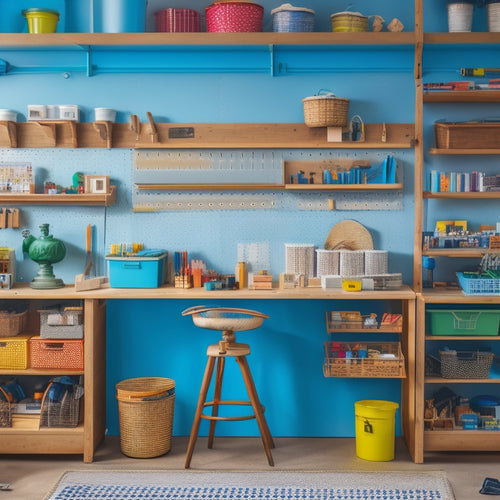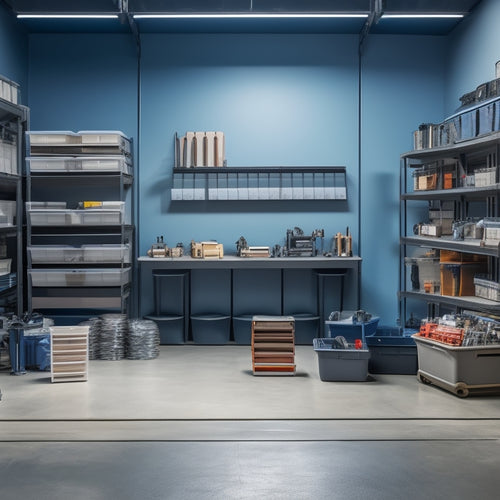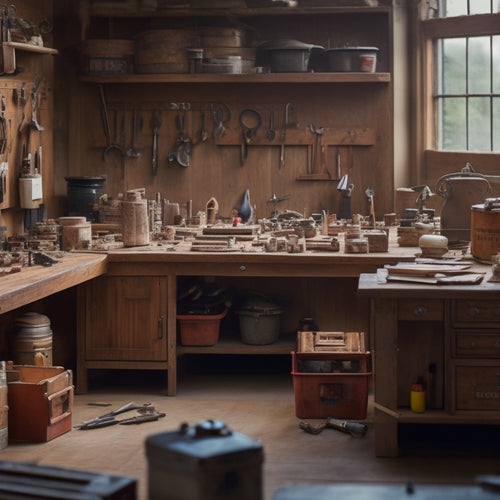
Building a Garage Storage System With Built-Ins
Share
You're about to build a garage storage system with built-ins that fits your unique needs, starting by evaluating your storage needs, planning the system, and choosing materials and tools. Measure your garage space, noting obstructions, and categorize items to store into types like shelving, cabinets, and hooks. Design activity zones for specific activities, optimize flow, and guarantee movement and access. Next, you'll build base cabinets, install shelving and hooks, and add workstations and countertops. Finally, incorporate bins and baskets, and establish habits for maintaining organization. Now that you've got a solid foundation, move forward to create a customized system that streamlines your garage.
Key Takeaways
- Assess storage needs by inventorying items, evaluating frequency of use, and determining organizational strategies like bins, shelves, and workbenches.
- Plan the built-in system by measuring available space, categorizing items into storage types, and designing dedicated zones for activities.
- Choose durable materials like wood, metal, or composite, and select a mix of power and hand tools for construction, considering weight capacity and cost.
- Design the storage layout to maximize space, employing vertical areas with wall-mounted shelves and hooks, and designate zones for specific activities.
- Install shelving, cabinets, and hooks, ensuring accessibility and comfort, and add workstations and countertops for a functional and organized garage.
Assessing Garage Storage Needs
As you stand in your garage, surrounded by clutter and chaos, it's clear that something needs to change. To create a functional and safe storage system, you need to assess your garage storage needs.
Start by taking inventory of the items you want to store, including their sizes and weights. Consider the frequency of use and how often you'll need to access them.
Next, think about the organizational strategies that will work best for you. Will you use bins, baskets, or shelves? Do you need a workbench or a dedicated area for hobbies? Identify the zones you want to create, such as a tool zone, sports equipment zone, or seasonal decoration zone.
When considering sizing, think about the dimensions of your garage and the space available for storage. Measure the walls, ceiling, and any obstructions to determine the maximum size of your storage units.
Don't forget to leave clearance for easy access and movement. By understanding your storage needs and requirements, you'll be able to design a system that keeps your garage organized, safe, and functional.
Planning the Built-In System
You'll need to define your storage needs by making a list of the items you want to store, including their sizes and quantities.
Next, measure the available space in your garage, taking note of any obstacles like windows, doors, or plumbing fixtures.
Define Storage Needs
When planning a built-in garage storage system, identifying your specific storage needs is essential to creating a space that truly serves your requirements. Start by making a list of the items you need to store, including tools, sports equipment, seasonal decorations, and other garage essentials.
Categorize these items into storage types, such as shelving, cabinets, hooks, and bins. Consider the frequency of use and the level of accessibility required for each item.
Next, think about your organization strategies. Do you prefer a tidy and compact storage system or a more open and accessible one?
Do you need dedicated zones for specific activities, such as a workspace or a sports equipment area? Consider the flow of your garage and how you can design your storage system to optimize efficiency and safety.
Measure Available Space
Now that you've defined your storage needs, it's time to assess the physical space where your built-in garage storage system will come to life.
Take out your tape measure and notebook, and let's get started!
Measure the length, width, and height of your garage, noting any obstructions like windows, doors, or plumbing fixtures.
Record these garage dimensions to guarantee your built-in system fits snugly.
Consider the space optimization strategies you'll use to make the most of your garage's unique shape.
- You're one step closer to a clutter-free garage that sparks joy!
- A well-planned built-in system means no more wasted space or forgotten items.
- Imagine the sense of accomplishment when your garage is altered into a functional haven!
Choosing Materials and Tools
Selecting the right materials and tools is an essential step in building an effective garage storage system. You'll want to choose materials that are durable, resistant to moisture, and can withstand the garage environment. Consider using wood, metal, or composite materials for your built-ins.
For tool selection, you'll need a mix of power tools, such as a circular saw and drill, and hand tools, like a tape measure and level.
Durability considerations should also play a role in your material choices. Assess the weight capacity of your shelves and cabinets to guarantee they can hold the items you plan to store. Conduct a cost analysis to determine the most cost-effective options without sacrificing quality.
When it comes to installation techniques, consider using screws instead of nails for added strength. Finish options, such as paint or stain, can enhance the appearance of your built-ins.
Don't forget to prioritize safety equipment, like safety glasses and a dust mask, to protect yourself during the build process. Finally, have maintenance tools, like a screwdriver and wrench, on hand to make future adjustments and repairs easier.
Designing the Storage Layout
You'll start designing your garage storage layout by maximizing floor space, which means measuring the area carefully and deciding where to place your storage units, workbenches, and other essentials.
Next, you'll want to employ vertical areas by planning where to install wall-mounted shelves, hooks, and cabinets to keep items off the floor and out of the way.
Maximizing Floor Space
Designing an efficient storage layout is essential to maximizing your garage's floor space. You want to make the most of the area you have, ensuring that every inch is employed effectively.
To achieve this, focus on creative storage solutions that prioritize floor organization. Consider incorporating multifunctional furniture, such as a workbench with built-in cabinets or a storage ottoman, to optimize space efficiency.
Some decluttering strategies to keep in mind:
-
Designate zones: Divide your garage into distinct areas for specific activities, like a workspace or a storage zone, to maintain organization and reduce clutter.
-
Choose flexible storage: Invest in modular shelving or bins that can be easily rearranged as your storage needs change.
-
Keep frequently used items accessible: Store often-used items in easy-to-reach locations, reserving higher or lower shelves for less frequently used items.
Utilizing Vertical Areas
Your garage's walls and ceiling offer a wealth of untapped storage potential. By utilizing vertical areas, you can maximize your garage's storage capacity without sacrificing floor space.
Start by installing wall-mounted racks for bikes, tools, and other equipment. These racks will keep your floor clear and your belongings organized.
Next, consider overhead storage options like ceiling-mounted bins or baskets. These are perfect for storing seasonal decorations, out-of-season clothing, or other items that you don't need frequent access to.
For more accessible storage, install pegboard solutions on your walls or on the back of a door. These allow you to hang tools, accessories, and other items within easy reach.
Modular shelving is another great option for vertical storage. You can customize the shelves to fit your specific needs, whether it's storing boxes, bins, or even a vertical gardening system.
Finally, don't forget to incorporate tool organization systems, like hooks and bins, to keep your tools tidy and easily accessible.
Building the Base Cabinets
Tackle the base cabinets by preparing the floor space where they'll sit. Make certain the area is level, clean, and dry. Check for any obstructions, such as pipes or electrical outlets, and mark their locations. Measure the space to determine the ideal cabinet size and layout.
Next, decide on the cabinet style that suits your needs. Do you prefer modern and sleek, traditional, or a combination of both? Consider the hardware options, including handles, knobs, or sliding doors. Choose a style that complements your garage's overall aesthetic.
- Imagine the sense of accomplishment when your cabinets are complete and your garage is organized!
- Visualize the satisfaction of having a dedicated space for your tools and equipment!
- Envision the relief of having a clutter-free garage that's safe and functional!
Once you've finalized the design, gather the necessary materials and tools. Cut the cabinet frames according to your measurements, and assemble them using screws or nails.
Attach the back panels, shelves, and hardware. Finally, install the cabinets in their designated spaces, making sure they're secure and level.
Installing Shelving and Hooks
With your base cabinets in place, it's time to maximize your garage's vertical storage potential by installing shelving and hooks.
You'll want to choose shelving types that fit your specific storage needs, such as fixed shelves for heavy items, adjustable shelves for flexibility, or slatwall shelves for hanging bins and accessories.
When deciding on hook placements, consider the items you'll be storing and their weight. Install heavy-duty hooks for bicycles, lawn equipment, or tools, and lighter hooks for bins, accessories, or seasonal decorations.
Make certain to space hooks evenly and at a comfortable height to avoid straining or overreaching.
Before installing, verify your walls can support the weight of your shelving and hooks. Check the manufacturer's instructions and local building codes for guidance.
Use a level to verify your shelves are straight, and anchor your shelving securely to the wall to prevent tipping or collapse.
Adding Workstations and Countertops
A well-organized garage often includes a dedicated workspace where you can tinker with projects, repair equipment, or simply have a convenient surface for everyday tasks.
This workstation should be designed with ergonomics in mind, guaranteeing you have ample space to move around and work comfortably. Consider the type of tasks you'll be performing and the tools you'll need within easy reach.
-
Imagine having a dedicated area for your favorite hobbies, where you can spread out your materials and focus on your craft.
-
Visualize a countertop that's resistant to stains and scratches, making cleanup a breeze.
-
Envision a workspace that's well-lit and ventilated, reducing eye strain and fatigue.
When selecting countertop materials, choose options that are durable, easy to clean, and resistant to chemicals and moisture.
Consider materials like stainless steel, granite, or butcher block. Confirm your workstation is at a comfortable height, and invest in a sturdy chair or stool to reduce fatigue.
Incorporating Bins and Baskets
Your garage storage system isn't complete without a thoughtful system for storing small items and keeping clutter at bay. To achieve this, incorporate bins and baskets into your design.
Start by identifying the types of items you need to store, such as sports equipment, tools, or cleaning supplies. Then, choose bin organization systems that fit your needs, considering factors like size, material, and accessibility.
Select basket styles that complement your garage's aesthetic while providing functional storage. For example, woven baskets can add a touch of warmth, while metal baskets offer durability.
Consider installing bins and baskets at different heights to accommodate items of varying sizes and to maximize vertical storage space. Label each bin and basket to guarantee easy identification and retrieval of items.
This thoughtful approach will help maintain a clutter-free garage and guarantee you can quickly find what you need. By incorporating bins and baskets, you'll create a well-organized and efficient garage storage system.
Final Touches and Maintenance
Beyond the initial setup of your garage storage system, it's vital to establish habits and routines to maintain its organization and functionality.
You've invested time and effort into creating a customized space, and now it's important to guarantee it remains clutter-free and efficient.
To achieve this, focus on adding the finishing touches and committing to regular upkeep.
This includes:
-
Scheduling monthly tidy sessions to maintain your system's organization and address any clutter buildup
-
Labeling and categorizing stored items to facilitate easy access and retrieval
-
Conducting seasonal deep cleans to remove dirt, dust, and debris that can compromise your system's performance
Frequently Asked Questions
Can I Build a Garage Storage System With Second-Hand Materials?
You can repurpose second-hand materials to create a budget-friendly storage system, but make certain you inspect items carefully for stability and safety; start by collecting sturdy pieces, then clean, disassemble, and reassemble them into functional storage solutions.
How Do I Protect My Built-Ins From Pests and Rodents?
"An ounce of prevention is worth a pound of cure." You prevent pest infestations by sealing all cracks, using rodent-resistant materials, and keeping your built-ins clean; then, control rodent access with door sweeps, caulk, and steel wool barriers.
Are There Any Garage Storage Systems Suitable for Small Garages?
You'll find garage storage systems perfect for small garages by opting for space-saving solutions like wall-mounted shelves and cabinets, and utilizing vertical storage options like overhead racks and stackable bins to maximize your space.
Can I Add Electrical Outlets to My Built-In Storage System?
Did you know 70% of garage fires are caused by electrical issues? You can safely add outlets to your built-in storage system by planning strategic outlet placement, following electrical safety codes, and hiring a licensed electrician to guarantee a secure installation.
Do I Need a Permit to Build a Garage Storage System?
You'll need to check with your local government to determine permit requirements for your project, as building codes vary; research and comply with regulations to guarantee a safe and compliant garage storage system.
Conclusion
You've successfully built a garage storage system with built-ins, a customized suit for your garage's unique needs! Now, your garage can finally breathe a sigh of relief, free from clutter and chaos. Just as a skilled chef orchestrates a kitchen, you've conducted a concert of storage, carefully composing each component to create a harmonious whole. With this system, you'll be whistling a happy tune every time you step into your garage.
Related Posts
-

Creative Workshop Storage Solutions and Ideas
You can revolutionize your workshop's storage by maximizing vertical space with wall-mounted racks, utilizing hidden ...
-

How to Maximize Storage Space With Parts Storage Bins
To maximize storage space with parts storage bins, start by evaluating your available storage space and examining you...
-

Top 7 Parts Tray Organizers for Productivity
You can optimize your workspace and enhance productivity with the right parts tray organizer, which can help you cate...


